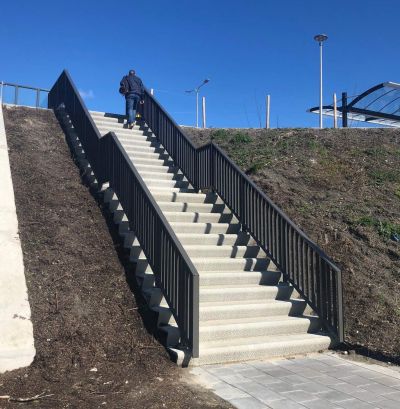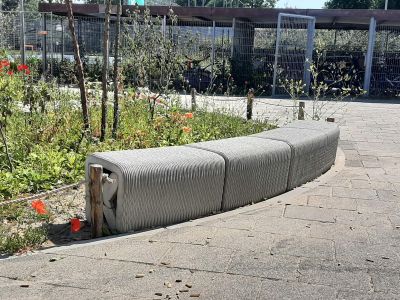3D concrete printing: more durable, faster and more design freedom
Saint-Gobain Weber had been experimenting with 3D printing of concrete since the beginning of this century and realized its first 3D printed wall in 2005. Over the following years, this experiment grew step-by-step into a new production method in construction. Products now roll out of the 3D concrete printer daily at the factory in Eindhoven. Peter Paul Cornelissen, Business Unit Manager 3D Printing, and Udo Snijer, Concrete Product Manager, talk about the advantages of 3D concrete printing and the possibilities the printing technology offers for public spaces.

The process
Cornelissen explains how the process works. “First, we use 3D software to create a design of a bridge, staircase or structural element. We receive this file from our clients. Often we then translate, together with the client, into a design that can be printed. This final design is divided into layers. We call this 'slicing' the design. These layers are then converted into a robot code so that the robot can print these layers on top of each other. In this way, the digital form is built up into a physical object.” Saint-Gobain Weber has since developed the technology to the point where we are the authority on 3D concrete printing.
Material savings
There is a big difference between the traditional way of pouring concrete and 3D printing concrete. Cornelissen: “In the traditional way, you work with a mold into which reinforcement steel is first placed and then concrete is poured. With 3D concrete printing, we only print concrete where it is needed. We print the contours and if it is necessary for strength, we print a structure in the cavities at the same time to support the forces. In projects, this results in a CO2 reduction of 50 to 70 percent.” Saint-Gobain Weber is also taking sustainability even further. Snijer: “We are investigating whether we can completely replace the cement in concrete mortar. The first step in this has been taken with Weber 3D Eco, a product with 49 percent less CO2 emissions than traditional mortar. In this development, we are building on the vast knowledge available within Saint-Gobain Weber.”


Efficient production
Saint-Gobain Weber facilitates a fully digitized process, which reduces the margin of error, allows objects to be delivered quickly and significantly reduces on-site work. Cornelissen: “Another important advantage is that you need far fewer people because of robotization. Important in a time of staff shortages in the construction industry.” Almost every day, products are produced in which the printing process is largely or entirely automated. One example is slope stairs, for which there is a configurator on the website. With this handy tool you can easily design a staircase yourself. “We also produce objects on a project basis, such as the bridge in Nijmegen, the Milestone house in Eindhoven and the tower in Qatar.”
Shape Freedom
Virtually all shapes can be easily printed. Even shapes that were often impossible using traditional formwork. For example, you can easily make 30 skate elements and vary them all slightly. That is prohibitive with traditionally poured concrete.” For street furniture, he sees great potential: “Here, optimization per location, personalization and design freedom - especially with organic shapes - are the main advantages. 3D concrete printing is a perfect construction method when all unique shapes or dimensions are needed.

Projects
A recent fine showcase for the possibilities of 3D concrete printing in public spaces is the 400-square-meter skate park on the Esplanade de Paris La Défense in Paris, which was open to everyone during the Olympic Games. Cornelissen: “It was realized by Saint-Gobain (France) as sponsor of the Olympics. A number of skate elements for the skate park were pre-tested by leading skaters and influencers at the 3D concrete printing factory in Eindhoven.” There are many more high-profile projects to mention. On our website you can find a map with various projects that have now been realized using the 3D printing technique. Now that there are already quite a few great examples, Cornelissen and Snijer want to work on the growth of 3D concrete printing in the Benelux in the coming period. Cornelissen is confident: “Especially with street furniture, clients are increasingly starting to see the benefits.”
Saint-Gobain Weber is the authority on 3D concrete printing.
